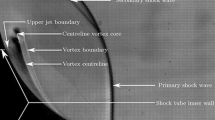Abstract
The presence of an adverse pressure gradient, shock/shock interaction and shock wave/boundary layer interaction often induces flow separation around bodies. However, the effect of dissociated flow on separated flow characteristics, especially at hypersonic speeds, is still not clear, and considerable differences are observed between experiments and numerical simulations. In this investigation, the unsteady separated flow features around double cones are visualized in the Shock Wave Research Center (SWRC) free-piston driven shock tunnel at a nominal Mach Number of 6.99 using multiple optical techniques. The time resolved shock structure oscillations in the flow field around double cones (first cone, semi-apex angle = 25°; second cone, semi-apex angles=50°, 65°, 68° and 70°) have been visualized using a high-speed image converter camera (IMACON) at a nominal stagnation enthalpy of 4.8 MJ/kg. In addition, flow visualization studies around the double cone is also carried out using Schlieren and double exposure holographic interferometry in order to precisely locate the separation point and measure the separation length. The presence of a triple shock structure in front of the second cone and a non-linear unsteady shock structure oscillation in the flow field are the significant results from visualization studies on the 25° /65°, 25° /68° and 25°/70° double cones. On the other hand, the flow field around 25° /50° is relatively steady and Type V shock/shock interaction is observed. Illustrative numerical simulation studies are carried out by solving N-S equations to complement the experiments. The simulated flow features around a double cone agree well qualitatively with experiments.
Similar content being viewed by others
References
Chanetz, B. Benay, R., Bousquet, J. M., Bur, R., Pot, T., Grassp F. and Moss, J., Experimental and Numerical Study of the Laminar Separation in Hypersonic Flow, AerospaceScience andTechnology, 3(1998), 205.
Edney, B., Anomalous Heat Transfer and Pressure Distribution on Blunt Bodies at Hypersonic Speeds in the Presence of an Impinging Shock, FFA Report, (1968), 115.
Rudy, D. H., Thomas, J. L., Ajay Kunar, P., Gnoffo A. and Chakravarthy, S. R., Computation of Laminar Hypersonic Compression Corner FlowsAIAA J., 29-7(1991), 1108.
Jagadeesh, G., Reddy, K. P. J., Naitou, K., Hashimoto, T., Sun, M. and Takayama, K., Study of the Separated High Enthalpy Flow Around a Double Cone, AIAA, (2002), 2002–0299.
Jean-PaulDavis and Bradford Sturtevant, Separation Length in High-Enthalpy Shock/Boundary Layer Interaction,Phyic of Fluids, 12-10(2000), 2661.
Olejniczak, J., Wright, M. J. and Candler, G.V., Numerical Study of Inviscid Shock Interactions on Double-Wedge Geometries,J. Fluid Mechanics, 352(1997), 1.
Hashimoto, T., Naitou, K. and Takayama, K., Density Measurement Over Sphere in Free Piston Driven Shock Tunnel, AIAA (2001), 2001–1770.
Takayama, K., Application of Holographic Interferometry to Shock Wave Research, Proc. of the Society of Photo-Optical Instrumentation Engineers, 398(1983), 174.
Sun, M., Numerical and Experimental Studies of Shock Wave Interaction With Bodies, Ph.D. Thesis, Tohoku University, Japan, (1999).
Wright, M. J., Sinha, K., Olejniczak, J. and Candler, G. V., Numerical and Experimental Investigation of Double-Cone Shock Interactions, AIAA J., 38-12(2000), 2268.
Author information
Authors and Affiliations
Additional information
Gopalan Jagadeesh: He received his B.E. (Eng) degree in mechanical engineering from Bangalore University, India in 1989, his M.E. (Heat power Eng.) from Birla Institute of Science, Mesra, Ranchi, India in 1991 and his Ph.D. (Aerospace Engineering) from the Department of Aerospace Engineering, Indian Institute of Science, Bangalore, India in 1998. After receiving his Ph.D. he was a Visiting Lecturer at the Shock Wave Research Center, Tohoku University before taking up his current position as Assistant Professor in the Dept. of Aerospace Eng., Indian Institute of Science, Bangalore. His research interests include hypersonic aero-thermodynamics, and industrial and biological applications of shock waves.
Tokitada Hashimoto: He received his B.Sc.(Eng.) degree in 1998 and his M.Sc(Eng.) degree in 2000 in Mechanical Engineering from Tohoku University. He is currently a Ph.D. candidate. His research interests include hypersonic flows and optical measurement technique.
Miyagno Sun: He received his B.Sc. degree in 1993 and his M.Eng. degree in 1995 from the Department of Mechanics of the University of Science & Technology of China, and his Ph.D. in Aeronautics and Space Engineering in 1998 from Tohoku University. After receiving his Ph.D., he became a research associate of the Shock Wave Research Center, Tohoku University. His primary research interest is basic wave phenomenon. He has developed a solution-adaptive code using unstructured quadrilaterals for accurately and efficiently capturing propagation and interaction of shock waves.
Kazuyoshi Takayama: He received his B.Sc. (Eng.) degree in Mechanical Engineering in 1963 from Nagoya Institute of Technology, his M.Sc. (Eng.) degree in 1965 and his Ph.D. in Mechanical Engineering in 1973 from Tohoku University. In 1986, he was promoted to professor of Tohoku University, and in 1988 was appointed director of the Shock Wave Research Center, Institute of Fluid Science, Tohoku University. His primary interests are in the basic research of shock wave dynamics. He has intensively studied double exposure holographic interferometry for use in shock wave research. The results of his shock wave research have been successfully applied to various fields of science, technology, and industry.
Rights and permissions
About this article
Cite this article
Jagadeesh, G., Hashimoto, T., Naitou, K. et al. Visualization of unsteady shock oscillations in the High-enthalpy flow field around double cones. J Vis 6, 195–203 (2003). https://doi.org/10.1007/BF03181624
Received:
Revised:
Issue Date:
DOI: https://doi.org/10.1007/BF03181624




